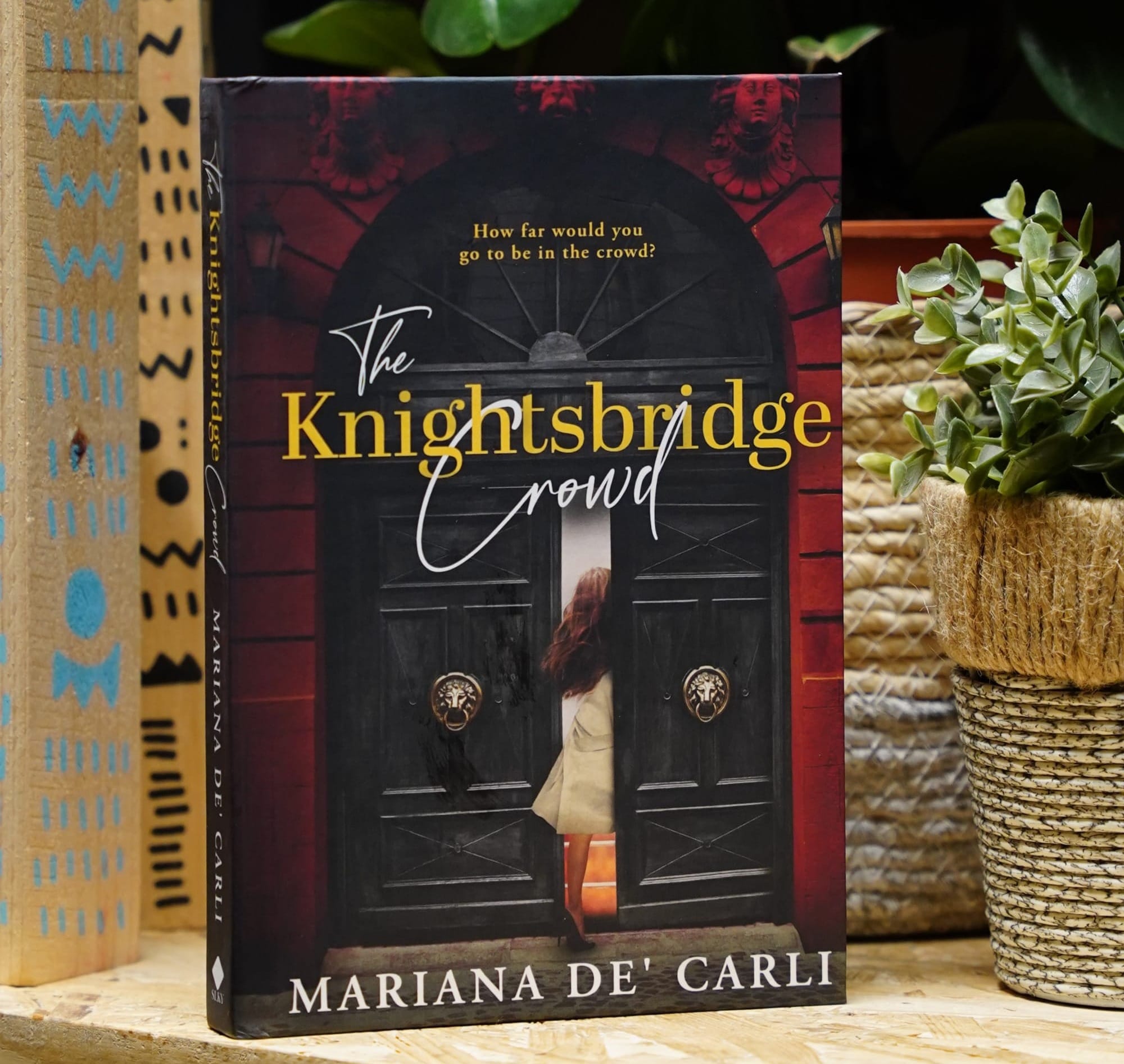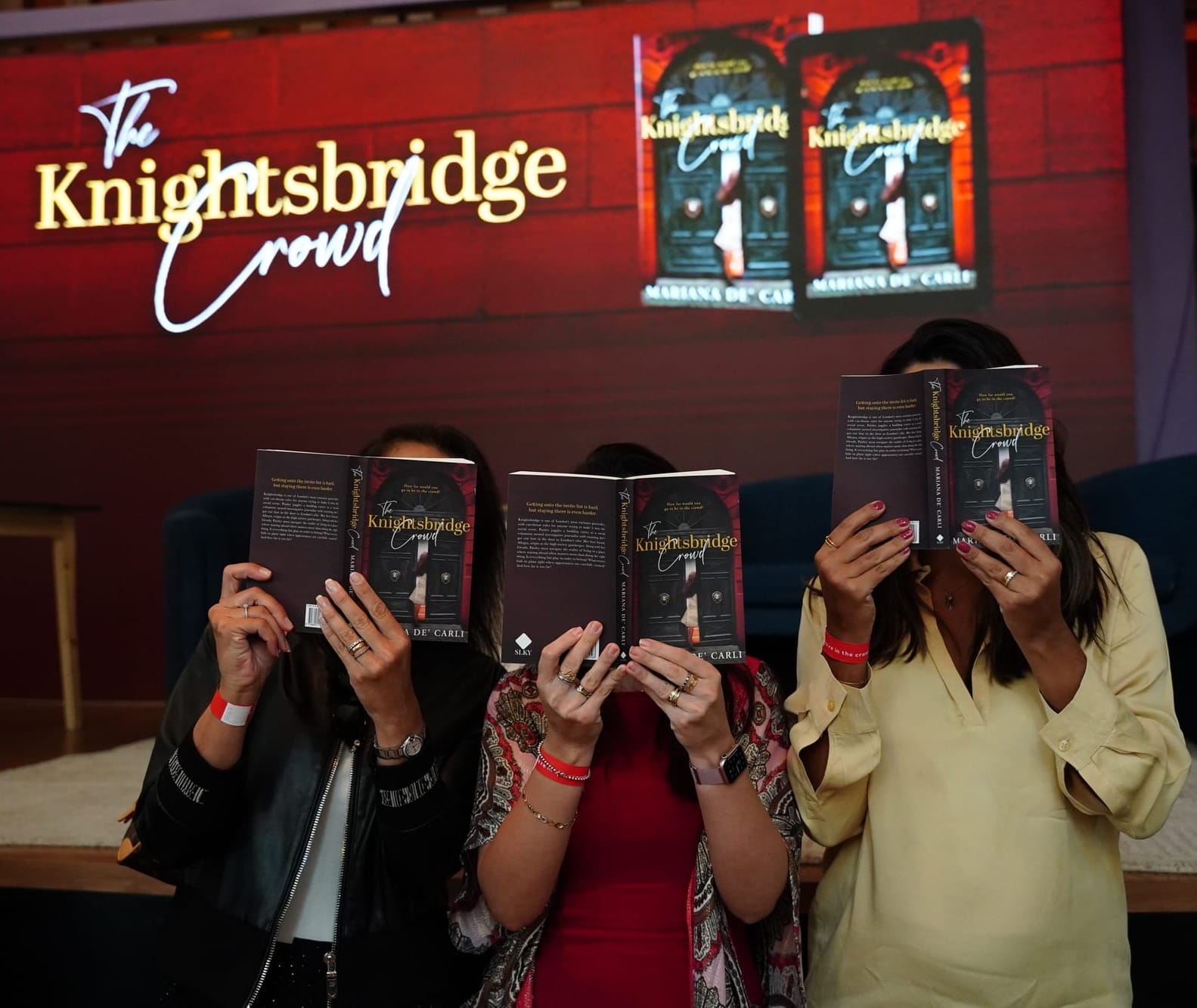A Riyadh Pen in London’s High Society

Meet Mariana De’ Carli, the Riyadh-based author behind The Knightsbridge Crowd
A bold debut uncovering the world behind London’s luxury
Table of Contents
- Author Spotlight: Mariana De’ Carli
- Inside The Knightsbridge Crowd
- Q&A with Author Mariana De’ Carli
- Purchase Your Copy
- Final Reflection
1. Author Spotlight: Mariana De’ Carli
Mariana De’ Carli’s multicultural journey—growing up in Brazil, studying and working in the UK, and now residing in Saudi Arabia—naturally informs her writing. With a background that spans languages, law, marketing, and neuroscience, she brings a layered understanding of how people navigate systems, relationships, and image-making. These interests translate into her fiction through the lens of social observation rather than sweeping commentary.
While London offered the setting and inspiration for The Knightsbridge Crowd, it was in Riyadh that the book took shape. The quiet rhythm of life, paired with the distance from the story’s setting, gave Mariana the clarity to reflect, process, and create. Her voice is observant and measured, shaped by real-world diplomacy and cross-cultural nuance, rather than literary affectation. As a debut novelist, she avoids overreaching in her tone and lets character dynamics and environment carry the weight of the narrative.
2. Inside The Knightsbridge Crowd
Set in London’s affluent Knightsbridge district, the novel follows Paisley Taylor, a social columnist turned reluctant investigator, as she drifts deeper into the lives of the city’s elite. Through galas, gallery openings, and high-stakes friendships, she uncovers the often unspoken costs of belonging. The novel is not driven by a single dramatic event, but by layered moments of tension, coded language, and social navigation.
Key Characters:
- Paisley “Paze” Taylor – A keen observer, struggling with the gap between proximity and acceptance.
- Allegra – Poised, magnetic, and central to the book’s unspoken power structure.
- Mansour – One of the few grounded characters, offering contrast and cultural nuance.
- Sara Gram & Florence Moray – Figures of status, ambiguity, and influence.
The Knightsbridge Crowd focuses more on atmosphere and implication than plot twists. Mariana’s style favours internal friction over spectacle. What emerges is a story about performance—how people curate themselves to gain access, and what they hide to stay there. The writing is restrained but purposeful, using a luxury backdrop not for escapism, but as a reflection of deeper personal negotiations.
3. Q&A with the Author: Mariana De’ Carli Up Close
From Brazil to London to Riyadh — Mariana’s perspective has been shaped by culture, transition, and the realities of working in high-stakes diplomatic environments. She wrote her debut novel between job responsibilities and personal reflection, often drawing on her academic grounding in neuroscience and linguistics to understand behaviour more deeply.
Q1: How did living in Brazil, the UK, and now Saudi shape your writing voice?
Brazil is a deeply artistic country. Everything from the music to how people speak feels expressive, textured, and alive. Growing up there made me attuned to the atmosphere. That early immersion in creativity shaped my instinct to write in vivid, sensory ways and bring my surroundings to life on the page.
Then there were the years in the UK, which were pivotal. I spent most of my formative years there, and that is where I truly became a writer. It influenced my use of British English and my entire approach to narrative. London taught me about subtext, restraint, and emotional layering. I became fascinated by the subtlety of grey morality, by what people conceal beneath polished surfaces. The story in this book is centred in London, and that influence runs deep in its structure, tone, and characters.
Saudi Arabia is where writing became part of my daily life. I began drafting this novel when I first started venturing out again after the pandemic. I had just moved to Riyadh and joined the Writers in Riyadh group to make creative connections in a new city. What started as a social commitment quickly became a serious turning point. Sharing work and receiving thoughtful critique gave me the discipline, confidence, and community I needed to bring the novel to life.
Q2: Why was it important for you to include a character like Mansour?
Mansour was always essential. He was never designed to be a supporting character in the background. His presence in the story is deliberate and layered. I wanted to write someone who challenges assumptions without being reduced to a symbol. He moves through elite spaces easily, but beneath that confidence is a quiet solitude that follows him wherever he goes.
Characters like him are often overlooked or flattened into stereotypes, especially in Western fiction. I felt strongly about giving him emotional depth and contradictions. He is generous and calculating, warm and withholding. He holds back even as he draws people in. His personal history, particularly his relationship with family and loyalty, adds weight to the emotional structure of the book. Without him, the narrative would lose some of its tension and complexity.
He is also one of the few characters who can navigate multiple worlds, and that duality is powerful. He reflects a kind of modern masculinity: refined and fractured, capable of charm yet shaped by a sense of loss that he cannot easily name. He is central not just to the plot but to its atmosphere, and will also play a major role in how the story unfolds in the upcoming second book “The Marbella Crowd”.
Q3: How did you balance the glamour and emotional tension in the story?
For me, glamour only works when it serves something deeper. It should never exist for its own sake. In The Knightsbridge Crowd, the world's beauty is seductive but also a mask. The parties, designer clothes, art collections, and opulent settings are not there to impress. They are there to conceal. Beneath every curated image is something brittle, something at risk of breaking.
I was drawn to that tension. I wanted to show how people can live surrounded by privilege and still feel entirely exposed. The glamour invites you in, but once inside, you begin to notice what is missing: emotional honesty, safety, and love that is not transactional. Every polished surface in the book reflects a deeper flaw. That is what keeps the story from floating. The stakes are real, and they hurt.
The key was writing characters who are complicit in the illusion but also quietly aware of its cost. They play the roles expected of them, but the reader is always allowed to see the cracks forming. That is where the story breathes.

4. Purchase Your Copy
The Knightsbridge Crowd is available worldwide on Amazon and can also be found at notable bookstores such as Barnes & Noble, Foyles in London, and the Harvard Bookstore. The novel is currently published in English, with translations into Portuguese and Spanish in progress.
Purchase your copy from these trusted retailers:
Whether you’re reading from Riyadh, London, or beyond, Mariana’s debut is within reach.
5. Final Reflection
The Knightsbridge Crowd offers a quiet yet thoughtful exploration of what it means to belong. Through her characters, Mariana De’ Carli invites readers to step behind the glamour and reflect on the choices people make to protect their place in the world. It’s a story that asks, with subtlety and care: what would you give to be part of something—and what might it cost to stay?
This article is part of a sponsored collaboration with the author. Al Jalees Times highlights emerging voices that reflect culture, challenge perception, and invite readers into global conversations.

